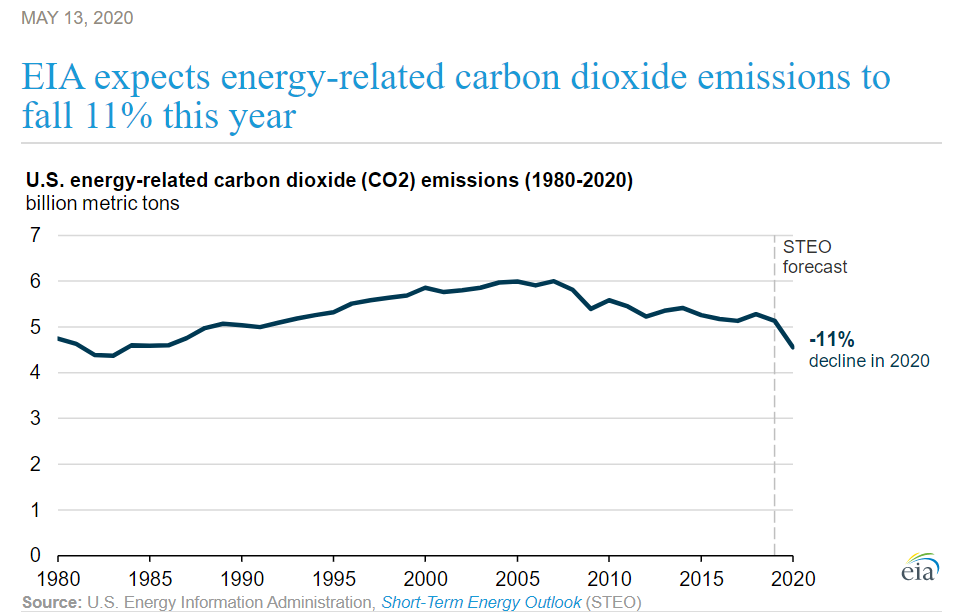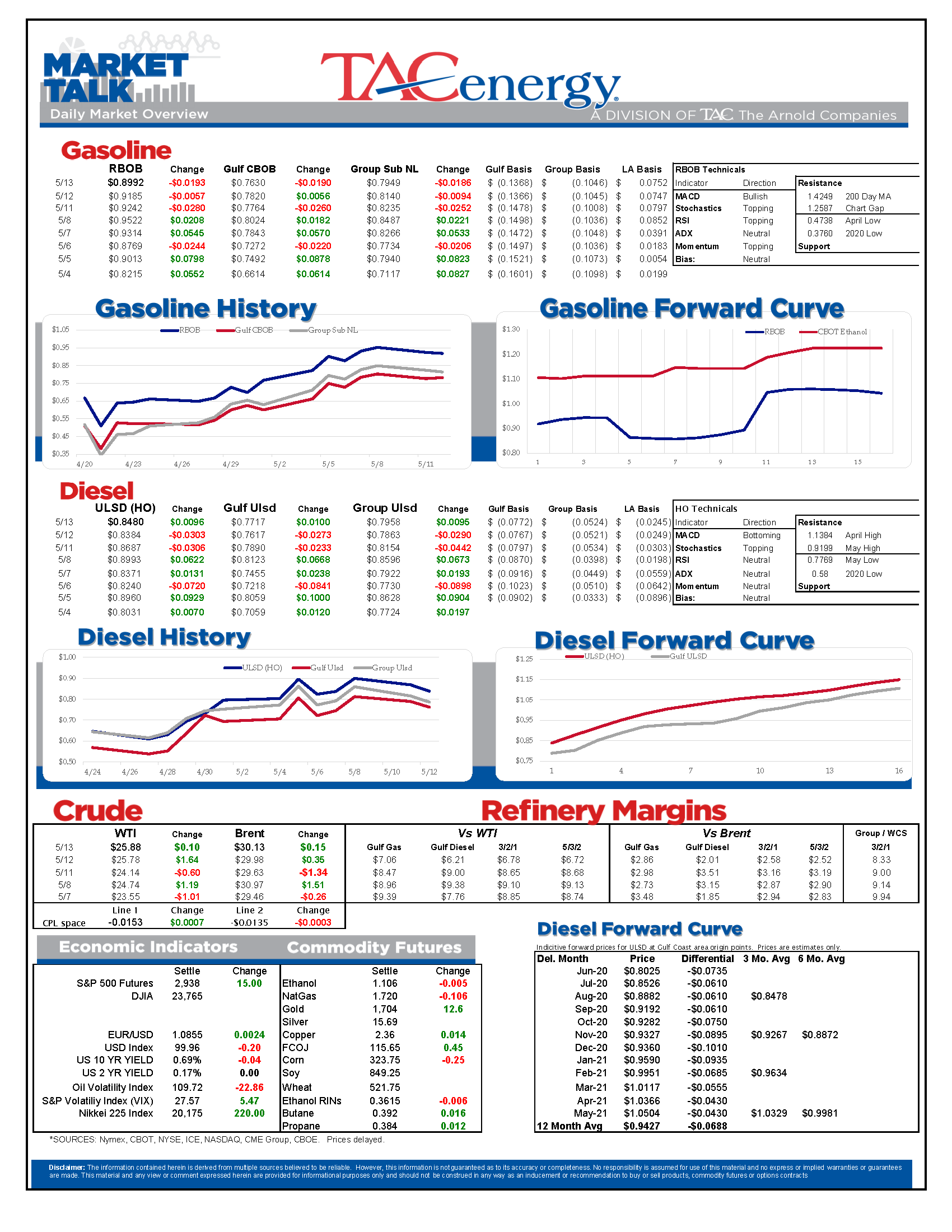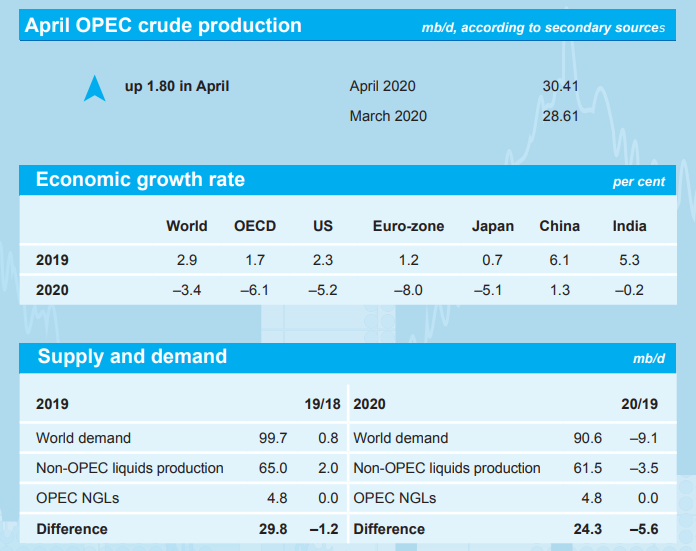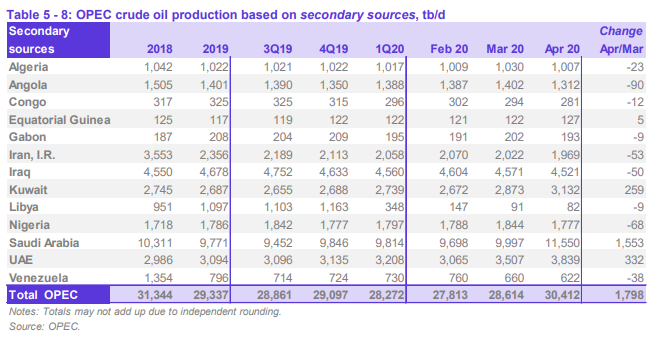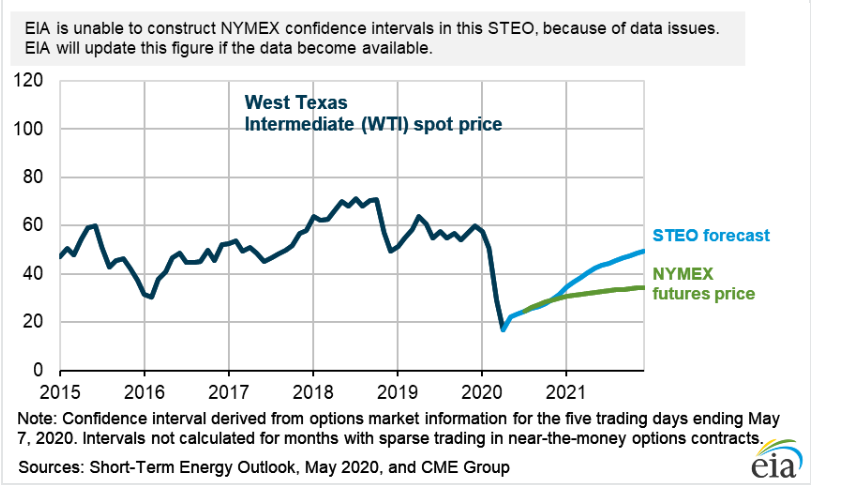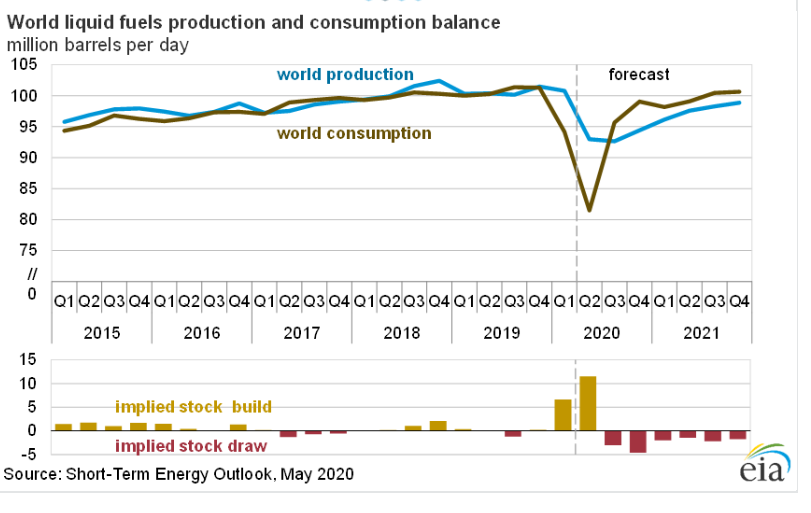Debate Over Economic Restarts Face Off Against Fears

The holding pattern continues for oil prices this week as a debate over signs of economic restarts, both domestically and abroad, face off against fears of a second-wave of the coronavirus. WTI and ULSD futures are both holding in their recent trading range, while RBOB futures are breaking their upward trend, and threatening a larger selloff.
We’re in the data-deluge week with the EIA, OPEC and IEA all releasing their monthly reports, in addition to the weekly API and DOE data. The first three of those reports have been released already and show a common theme of slowly improving fuel demand, spread unevenly across the various refined products.
OPEC’s oil output rose by 1.8 million barrels/day in April, as Saudi Arabia made good on its threat to flood the global market right as the world was experiencing the largest demand drop in history. That story should flip in May as the price war has ended, and country’s slowly reopen for business.
The API was reported to estimate that U.S. oil inventories built by 7.5 million barrels last week, which was larger than most published forecasts.
The industry group also estimated another gasoline inventory draw-down of 1.9 million barrels, while distillates were up by 4.7 million barrels. You’d be forgiven if you thought the API showed the opposite build/draw in inventories based on the price reaction overnight with RBOB down two cents and ULSD up one, which suggests the early action may have more to do with the charts after RBOB’s trend line broke Tuesday.
Wheels off the charts: The EIA’s monthly short term energy outlook showed how the wild action of the past two months has broken the mold. The front page of that report typically shows a price forecast for WTI, including 95 percent confidence intervals for those projections. This month the EIA is “unable to construct” those intervals because of “data issues” surrounding the extreme volatility and lack of liquidity in options markets it created. In other words, given the two standard deviation from the mean calculation of a confidence interval, and prices doing what they’ve done, the price estimate is around 30 dollars for WTI, but the confidence would be somewhere in the range of plus or minus $50/barrel from that mark.
The STEO was able to estimate that global energy consumption will start outpacing production in the back half of this year, and that energy related CO2 emissions would fall by 11 percent, the largest drop in over 70 years of data.
The DOE’s weekly report is due out at its regular time this morning. Watch the refinery yield and export figures to see how refineries are reacting to their undesirable transition from an excess of gasoline inventory to a glut of diesel. While it may take a few weeks for plants to shift gears, and longer still to show up in the data, the increased complexity and flexibility of many U.S. refineries seems to be more capable of solving the demand puzzle than ever before.
Click here to download a PDF of today's TACenergy Market Talk.
News & Views
View All
Energy Futures Are Caught Up In Headline Tug-O-War This Morning
Energy futures are caught up in headline tug-o-war this morning with Canadian oil production concerns and a positive US GDP report trying to push prices higher while sinking Chinese demand worries and Gaza ceasefire hopes are applying downward pressure. The latter two seem to be favored more so far this morning with WTI and Brent crude oil futures down ~45 cents per barrel, while gasoline and diesel prices are down about half a cent and two cents, respectively.
No news is good news? Chicago gasoline prices dropped nearly 30 cents yesterday, despite there not being any update on Exxon’s Joliet refinery after further damage was discovered Wednesday. Its tough to say if traders have realized the supply situation isn’t as bad as originally thought or if this historically volatile market is just being itself (aka ‘Chicago being Chicago’).
The rain isn’t letting up along the Texas Gulf Coast today and is forecasted to carry on through the weekend. While much of the greater Houston area is under flood watch, only two refineries are within the (more serious) flood warning area: Marathon’s Galveston Bay and Valero’s Texas City refineries. However, notification that more work is needed at Phillip’s 66 Borger refinery (up in the panhandle) is the only filing we’ve seen come through the TECQ, so far.
Premiums over the tariff on Colonial’s Line 1 (aka linespace value) returned to zero yesterday, and actually traded in the negatives, after its extended run of positive values atypical of this time of year. Line 1’s counterpart, Line 2, which carries distillates from Houston to Greensboro NC, has traded at a discount so far this year, due to the healthy, if not over-, supply of diesel along the eastern seaboard.
Click here to download a PDF of today's TACenergy Market Talk.

WTI And Brent Crude Oil Futures Are Trading ~$1.50 Per Barrel Lower In Pre-Market Trading
The across-the-board drawdown in national energy stockpiles, as reported by the Department of Energy yesterday, stoked bullish sentiment Wednesday and prompt month gasoline, diesel, and crude oil futures published gains on the day. Those gains are being given back this morning.
The surprise rate cut by the People’s Bank of China is being blamed for the selling we are seeing in energy markets this morning. While the interest rate drop in both short- and medium-term loans won’t likely affect energy prices outright, the concern lies in the overall economic health of the world’s second largest economy and crude oil consumer. Prompt month WTI and Brent crude oil futures are trading ~$1.50 per barrel lower in pre-market trading, gasoline and diesel are following suit, shaving off .0400-.0450 per gallon.
Chicagoland RBOB has maintained its 60-cent premium over New York prices through this morning and shows no sign of coming down any time soon. Quite the opposite in fact: the storm damage, which knocked Exxon Mobil’s Joliet refinery offline on 7/15, seems to be more extensive than initially thought, potentially extending the repair time and pushing back the expected return date.
There are three main refineries that feed the Chicago market, the impact from one of them shutting down abruptly can be seen in the charts derived from aforementioned data published by the DOE. Refinery throughput in PADD 2 dropped 183,000 barrels per day, driving gasoline stockpiles in the area down to a new 5-year seasonal low.
While it seems all is quiet on the Atlantic front (for now), America’s Refineryland is forecasted to receive non-stop rain and thunderstorms for the next four days. While it may not be as dramatic as a hurricane, flooding and power outages can shut down refineries, and cities for that matter, all the same, as we learned from Beryl.

